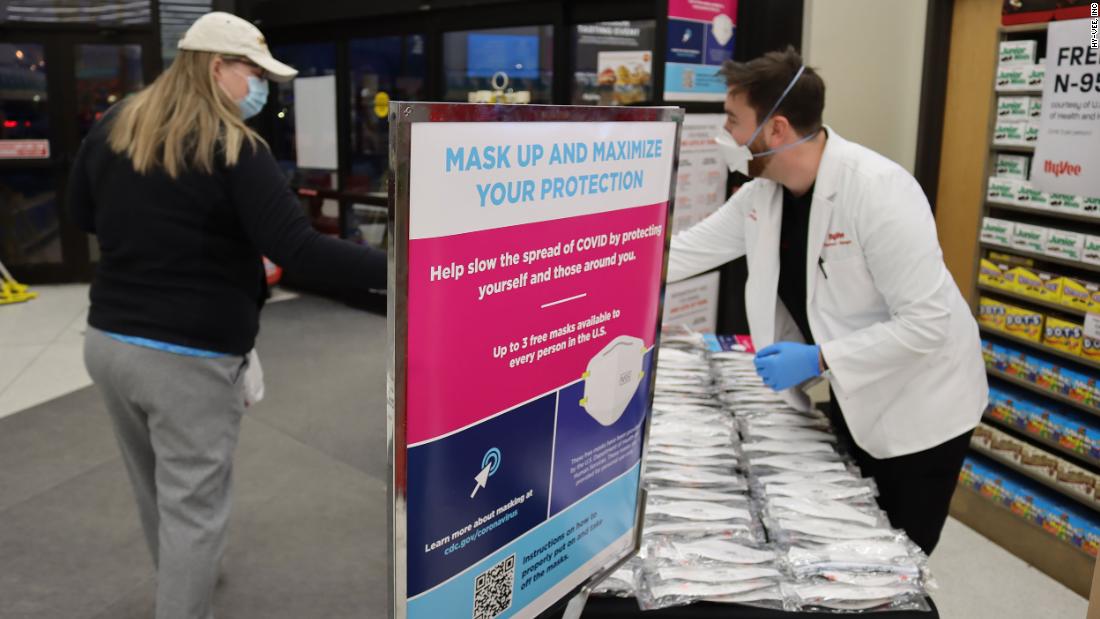Here’s how to get free N95 masks from pharmacies or community health centers
Participating pharmacies include Hy-Vee, Meijer, CVS, Walgreens and Kroger.
Some of the first masks arrived in the Midwest on Friday, including at Hy-Vee grocery stores in Iowa, Illinois, Minnesota, Missouri, Kansas, South Dakota, Wisconsin and Nebraska and at Meijer stores in Michigan, Ohio, Indiana, Illinois, Kentucky and Wisconsin.
Masks also are expected to start arriving at Southeastern Grocers locations as early as Friday, and they’ll be available at Fresco y Más, Harveys Supermarket and Winn-Dixie in-store pharmacies.
CVS pharmacies are also expected to receive and begin distributing free N95 masks in the coming weeks as supply from the federal government comes in, spokesman Matt Blanchette told CNN on Monday.
Walgreens expects that free N95 masks will be available at some locations starting Friday, according to a company spokesperson.
“We are pleased to partner with the Administration to make N95 masks in varying sizes available free of charge at participating Walgreens locations while supplies last,” a Walgreens spokesperson wrote in an email to CNN on Monday.
“Customers and patients can pick up a maximum of three masks per person,” the email noted. “We expect the first stores to begin offering masks on Friday, Jan. 28, and will continue on a rolling basis in the days and weeks following. Participating stores will have signage indicating mask availability.”
Kroger stores with pharmacies also plan to distribute free N95 masks, according to a company statement Monday.
“Wearing a mask and getting vaccinated continue to be the top defense tools in our nation’s fight against COVID-19. I encourage everyone to take advantage of the free non-surgical N95 masks and make an appointment today to get vaccinated or boosted,” Dr. Marc Watkins, Kroger’s chief medical officer, said in the statement.
Community health centers are expected to distribute masks too, but on a smaller scale.
The Health Resources and Services Administration oversees the Community Health Centers program for the federal government and notes on its website that the HRSA Health Center COVID-19 N95 Mask Program will begin incrementally, providing N95 masks to about 100 to 200 health centers in the initial phase.
“These health centers should receive and start distributing masks before the end of January 2022,” according to the agency.
Farber added that the Health Resources and Services Administration anticipates that masks will be made available to all health centers by mid-February.
How many masks can I get?
The HHS flyer distributed with the free masks notes that up to three masks are “available to every person in the U.S.”
Pharmacies plan to monitor how many masks people are taking at a time to make sure they don’t take extra.
There have been no issues with people trying to take more than the allocated number of N95 masks at Hy-Vee locations, a company spokesperson told CNN on Monday.
“Each Hy-Vee store has designated employees to personally hand out up to three masks per person; we haven’t had an issue with people attempting to take more than the limit of three provided by HHS,” Christina Gayman, a spokesperson for Hy-Vee, wrote in an email. “Additional N95 masks are also for sale at our pharmacy locations if people want/need more.”
If the masks are at no cost to me, who paid for them?
The 400 million N95 masks amount to more than half of the 750 million stored in the Strategic National Stockpile, a figure that tripled over the past year as the White House sought to boost reserves.
Does this mean I should no longer wear other types of masks?
The US Centers for Disease Control and Prevention emphasizes that “any mask is better than no mask.”
The CDC recommends that Americans wear “the most protective mask you can that fits well and that you will wear consistently,” and it notes that different types of masks can offer different levels of protection.
“Loosely woven cloth products provide the least protection, layered finely woven products offer more protection, well-fitting disposable surgical masks and KN95s offer even more protection, and well-fitting NIOSH-approved respirators (including N95s) offer the highest level of protection,” according to the CDC.
By having a better fit and having certain materials — such as polypropylene fibers — acting as both mechanical and electrostatic barriers, N95 masks help to better prevent tiny particles from getting into the nose or mouth. They must be fitted to the face to be effective.
“CDC continues to recommend that any mask is better than no mask. And we do encourage all Americans to wear a well-fitting mask to protect themselves and prevent the spread of Covid-19,” CDC Director Dr. Rochelle Walensky said in a briefing this month. “And that recommendation is not going to change.”
![]()


